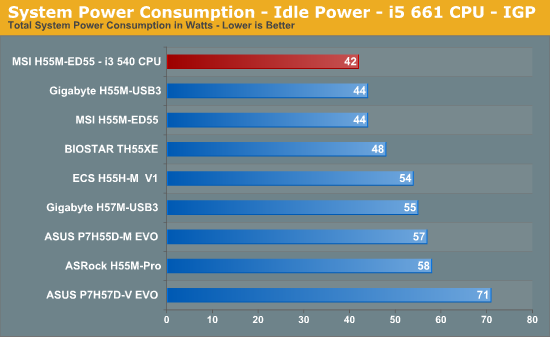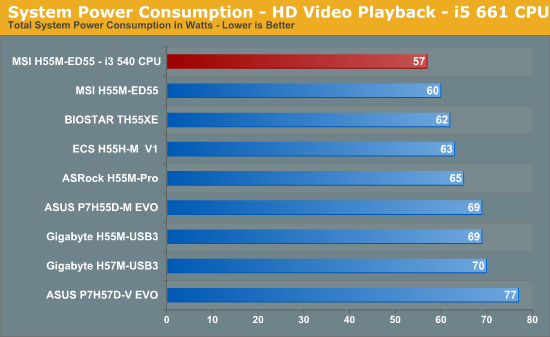Choosing the Best H55/H57 Motherboard, Part 2
by Rajinder Gill on February 22, 2010 2:00 AM EST- Posted in
- Motherboards
Test Bed Setup
| Testbed Setup Overclocking / Benchmark Testbed |
|
| Processor | Intel Core i5 661 ES CPU 3.33GHz, 2 Cores, 4 Threads, 4MB Cache Intel Core i3 540 CPU 3.07GHz, 2 Cores, 4 Threads, 4MB Cache |
| CPU Voltage | Various |
| Cooling | Intel air cooler Heatkiller 3.0 Waterblock PA120.2 Radiator DDC Ultra pump (with Petra top) 1/2 ID tubing |
| Power Supply | Corsair HX950 |
| Memory | Corsair Dominator CMD8GX3M4A1600C8 1600MHz 8GB kit. Rev 3.1 Corsair Dominator CMD8GX3M4A1600C8 1600MHz 8GB kit. Rev 7.1 Corsair XMS3 CMX8GX3M4A1333C9 1333MHz CAS 9 8GB kit. Rev 2.3 G.Skill Perfect Storm 8-8-8-24 2200MHz 4GB kit Corsair Dominator GT 8-8-8-24 2200MHz 4GB kit (two for 8GB) Rev 2.1 |
| Memory Settings | Various |
| Video Cards | MSI 275 Lightning (stock clocks) |
| Video Drivers | nVidia 195.62 WHQL |
| Hard Drive | Western Digital 7200RPM 1TB SATA 3Gbps 32MB OCZ Vertex 120GB SSD |
| Optical Drives | Pioneer DVR-215DBK |
| Case | Dimastech Benching Station (open) Lian-Li V2110 (closed) |
| Operating System | Windows 7 64-bit |
| . | |
We utilized memory kits from Corsair and G.Skill to verify memory compatibility on our test boards. Our OS and primary applications are loaded on the OCZ Vertex 120GB SSD drive and our games operate off the WD Caviar Black 1TB drive. We did a clean install of the OS and applications for each motherboard. We used Intel's stock cooler for the stock comparison testing, while water-cooling via the superlative Heat Killer 3.0 water block was utilized for overclocking. For graphics duty, we used MSI's GTX 275 Lighting GPU to provide performance comparisons between boards during gaming benchmarks.
For our test results we set up each board as closely as possible in regards to memory timings. Otherwise all other settings are left on auto. The P55 utilized 8GB of DDR3 (apart from DFI's MI-T36 which is limited to 4GB), while the X58 platform contained 6GB. The P55 and X58 DDR3 timings were set to 7-7-7-20 1T at DDR3-1600 for the i7-920 and i7-870 processors at both stock and overclocked CPU settings.
We used DDR3-1333 6-6-6-18 1T timings for the i5-750 stock setup for all system benchmarks (non-gaming tests) as DDR3-1600 is not natively supported at a stock BCLK setting of 133. For our Clarkdale i5 661 CPU, we used 7-7-7-20 1N timings at DDR3-1333MHz with 8GB of memory. We would have preferred to use CAS 6 timings to match our Lynnfield setup, but it seems 8GB of memory at CAS 6 on Clarkdale is not possible right now. The 4GHz gaming results used 8GB of memory at DDR3-1280MHz with CAS 6-6-6-18 1N timings to allow a BCLK of 200MHz.
Power Consumption
Our power consumption testing utilizes the same batch of components under similar circumstances in a bid to monitor variances between idle and CPU load conditions using an AC wall meter for power consumption measurements. We install the vendor supplied power saving utilities on each board and enable power saving modes that don't involve any kind of underclocking or CPU core frequency modulation in order to run an apples to apples comparison. Assuming a maximum 150w load in the worst case scenario, actual motherboard power consumption is around 15%~20% lower than the shown figures if you factor out switching losses at the PSU.



Best overall power consumption figures belong to MSI, while boards laden with USB 3.0 features and SATA 6G trail in both idle and load situations.










56 Comments
View All Comments
7Enigma - Monday, February 22, 2010 - link
Taft,Why does the MSRP really matter? Unless you are looking to buy in bulk, I don't really see what the benefit would be. For instance the Intel 80gig SSD has been inflated for months now. It's still a great product, and I don't know why someone wouldn't buy something if the price was higher than MSRP. Many electronic products sell below MSRP, and IMO that does't make them any better or worse.
More importantly than MSRP in my opinion is shopping around to get the best price at any given point. 15-30min of googling around to various E-tailers will give you a good ballpark of the price.
Rajinder Gill - Monday, February 22, 2010 - link
Hi,Unfortunately, I haven't seen or heard of any such resource from any of the sub-vendors - I usually have to fire off emails to ask. I agree with you though, it would be nice to see the figures posted on vendor websites.
regards
Raja
willsonjone - Tuesday, March 22, 2011 - link
Samsung, a respected brand keeps introducing mobile phones that match today’s speed and technology. Samsung has gone great lengths this time as it has received impressive reviews for its new Galaxy S 4G which happens to be the first 4G Phone with 21+ Mbps speeds.Samsung Galaxy S 4G
Kid98 - Monday, February 22, 2010 - link
(ASUS is using a 188 amp capable VRM vs a guessed 110~120amp VRM on the Gigabyte H55/H57 boards, so we'd pick the ASUS boards for Lynnfield CPU overclocking)Looks like the units used to express the capabilities of the VRM's is incorrect, otherwise I am going to need a really large PSU to run them....
Kid
Swivelguy2 - Monday, February 22, 2010 - link
That's 100+ amps delivered at a Vcore of ~1 volt, not 100+ amps drawn from the 12v rail.Earballs - Monday, February 22, 2010 - link
I don't understand these Farcry 2 benchmark results.How is this score against the i5 750 being calculated? Did you test all these boards with that processor then average it? :S
If the first result is the 661@stock and the second the 661@4Ghz, why is the comparison to the i5 750 number not the same in both charts? What changed for the 750? The graphics settings appear to be the same.
Rajinder Gill - Monday, February 22, 2010 - link
The 750 was benched on the EVGA P55 FTW board. Same drives, same drivers, same GPU, same patch version of FC2. Not sure why Lynn (4core) does worse in this bench.later
Raja
Earballs - Monday, February 22, 2010 - link
Okay thanks, but that doesn't explain this:If the first result is the 661@stock and the second the 661@4Ghz, why is the comparison to the i5 750 number not the same in both charts? What changed for the 750? The graphics settings appear to be the same.
Rajinder Gill - Monday, February 22, 2010 - link
Hi,The 750 was OC'd to 4GHz in the second chart, which is why the figure is 5FPS higher than the stock number of 68fps.
I can update the graph in about a day with the 750 running in one of the H55 boards if you like - got the Intel JG on the test rig at present and it won't do 4G's with the 750 I suspect..lol
regards
Raja
Earballs - Monday, February 22, 2010 - link
Ok. It might clear things up to have the 750 labeled as OC'd in the second chart. Thanks for the replies.